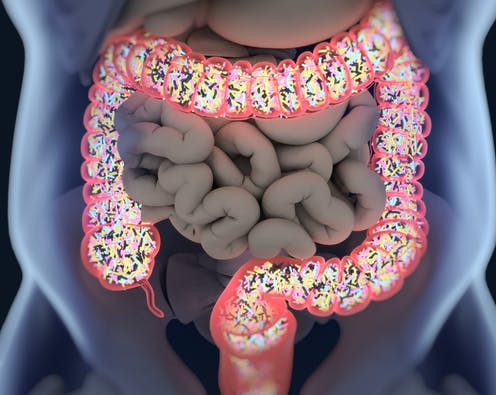Contents
The Holy Medicine of the Divine Mother Ayahuasca is very famous for purgatory effects. The indigenous people of the Amazons have been consuming the Holy Medicine for centuries and believe the purgatory effects cleanses the individual consuming the Holy Medicine physically, mentally and also spiritually.
Many find that one of the many things the Holy Medicine might have positively affected were their microbiome. Recent research and some leading researchers in the field suggest that Psychedelics, such as the Holy Medicine might affect the human mind and body by changing the gut at first.
According to scientists, the microbiome is the term that refers to the collection of bacteria, archaea, fungi, parasites, and viruses colonizing our body. We have microbial colonies all over our body: our gut, our skin, and even our brain. According to the researchers especially the gut microbiome plays a key role in a number of hard-to-treat disorders. Interestingly, our gut microbiome getting all out of order- a state scientifically known as dysbiosis- has been associated with several critical conditions such as GI disorders like psychiatric disorders like autism, depression, anxiety, and IBS.
Jane Foster, a leading microbiome researcher and head of Foster Lab at McMaster University in Hamilton, Ontario, suggests that the gut microbiome always has something to do with everything happening in our body. She and her colleagues are studying the microbiome’s connection to the brain at her lab, a link the researchers are currently calling the “gut-brain axis”. The gut-brain axis refers to the hormonal, endocrine, and neurological pathways that link the gut and the brain together. According to Foster, it is a system in which all our body systems interact.
Caitlin Thompson, a researcher in the neuroscience and chemistry field and the founder of her probiotic company called Ethneozen to assist people in treating dysbiosis, suggests Psychedelics such as the Holy Medicine might heal both psychiatric and GI conditions by acknowledging dysbiosis.
The indigenous people of the Amazons have been consuming the Holy Medicine as antiparasitic for thousands of years, and now the scientists are finding the Holy Medicine also contains compounds that show some antifungal and antibacterial activity, indicating that the Holy Medicine certainly affects the good and bad bacteria in the gut.
Brad Adams, a researcher, demonstrated that Psychedelics such as the Holy Medicine tend to assist psychological disorders which have more of a positive effect on the gut microbiome than any other available treatments suggest that the Holy Medicine is making the changes for the best.
The researchers observed that leaky gut syndrome could allow chemical messengers named inflammatory cytokines, which signal inflammation response, to leak out of the gut and circulate throughout the whole-body system, and eventually end up in the brain. Once in the brain, these molecules can stimulate the hypothalamic-pituitary axis (HPA)- a neural pathway. According to the researchers, continual activation of this HAP activation can cause problems over time.
Sarah Wakefield, a child and adolescent psychiatrist at the Texas Tech University in Lubbock, Texas, says, “The HPA is really our stress release axis that activates to tell our body that it is time to be stressed out”. HPA activation can be a good thing, the same way that our immune system can be good until it starts to attacking our bodies instead of invaders. According to Wakefield, inflammatory cytokines can induce that HPA axis to function when it is not helpful to function, which can gradually lead to anxiety and depression.
Preliminary researches in this field suggest Psychedelics, such as the Holy Medicine, reduce the production of inflammatory cytokines in the first place, nipping depression, stress, dysbiosis, and anxiety in the bud and improve symptoms of depression and anxiety. According to Jane Foster, Psychedelics act on serotonin receptors, which are distributed throughout the entire body but concentrated in the gut. Researchers also demonstrated that DMT, often contained with the Holy Medicine, also impact immunity through different kinds of receptors called sigma-1 receptors, which are suspected to also play a role in neurodegeneration.
It is possible that the Holy Medicine could be helping people maintain disease symptoms by adjusting immunity through its impact and treating dysbiosis on the gut. While Psychedelic therapy is still controversial, researchers agree that altering the microbiome’s composition could be important in treating disease originating from dysbiosis.
Conclusion
Foster and Thompson can see the immense promise and potentiality the Holy Medicine and other Psychedelics substances held and concluded that there is an even greater need for research into the direct link between the Holy Medicine, other Psychedelics and the microbiome.
References
- Carding, Simon et al. (2015). Dysbiosis of the gut microbiota in disease. Microbial ecology in health and disease, [online] Volume, 26, p. 26191. Available at: https://dx.doi.org/10.3402%2Fmehd.v26.26191 [Accessed 16th July 2021].
- Clapp, Megan et al. (2017). Gut microbiota’s effect on mental health: The gut-brain axis. Clinics and practice, [online] Volume, 7(4), p. 987. Available at: https://dx.doi.org/10.4081%2Fcp.2017.987 [Accessed 16th July 2021].
- Roumy V, Gutierrez-Choquevilca AL, Lopez Mesia JP, et al. (2015). In vitro Antimicrobial Activity of Traditional Plant Used in Mestizo Shamanism from the Peruvian Amazon in Case of Infectious Diseases. Pharmacognosy Magazine, [online] Volume, 11, p. S625-S633. Available at: https://dx.doi.org/10.4103%2F0973-1296.172975 [Accessed 16th July 2021].
- Szabo A, Kovacs A, Frecska E, Rajnavolgyi E (2014) Psychedelic N,N-Dimethyltryptamine and 5-Methoxy-N,N-Dimethyltryptamine Modulate Innate and Adaptive Inflammatory Responses through the Sigma-1 Receptor of Human Monocyte-Derived Dendritic Cells. PLoS ONE, [online] Volume, 9(8), p. 106533. Available at: https://doi.org/10.1371/journal.pone.0106533 [Accessed 2021].
- Szabo, A. (2015). Psychedelics and immunomodulation: novel approaches and therapeutic opportunities. Frontiers in Immunology, [online] Volume, 6, p. 358. Available at: https://doi.org/10.3389/fimmu.2015.00358 [Accessed 16th July 2021].
- Tupper, Kenneth W et al. (2015). Psychedelic medicine: a re-emerging therapeutic paradigm. CMAJ: Canadian Medical Association journal = journal de l’Association medicale Canadienne, [online] Volume, 187(14), p. 1054-1059. Available at: https://dx.doi.org/10.1503%2Fcmaj.141124 [Accessed 16th July 2021].
- Zaidi, M.I., Islamia Coll. (2004). Antifungal activity of harmine, HgCl2, and their complex. Sarhad Journal of Agriculture, [online] Available at: https://agris.fao.org/agris-search/search.do?recordID=PK2005000444 [Accessed 16th July 2021].


